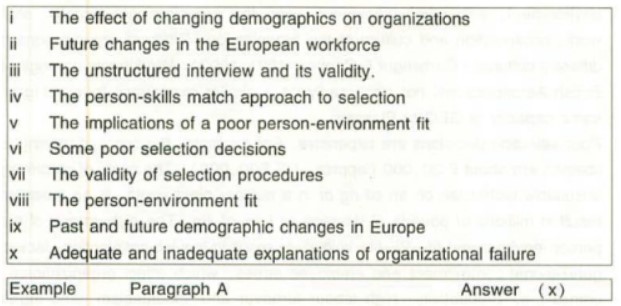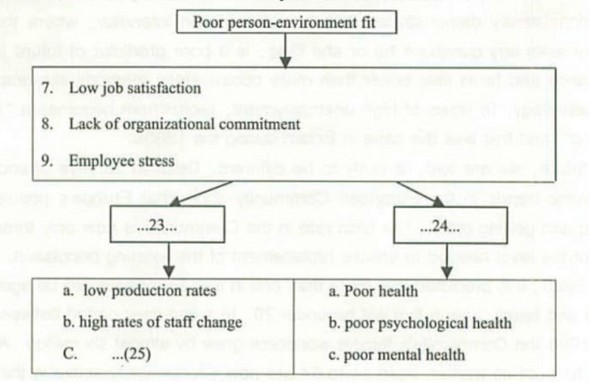IELTS Data Reading Passage 137 – People and Organizations: the Selection Issue
You should spend about 20 minutes on Questions 12-25 which are based on IELTS Data Reading Passage 137 – People and Organizations: the Selection Issue Reading Passage Below
Questions 12-16
IELTS Data Reading Passage 137 – People and Organizations: the Selection Issue Reading Passage 2 has seven paragraphs A-G. Choose the most suitable headings for paragraphs B-E and G from the list of headings below.
Write the appropriate numbers (1-x) in boxes 12-16 on your answer sheet.
NB There are more headings than paragraphs so you will not use all of them.
You may use any of the headings more than once.
List of Headings
Question 12. Paragraph B
Question 13. Paragraph C
Question 14. Paragraph D
Question 15. Paragraph E
Question 16. Paragraph G
People and Organizations: the Selection Issue
{A} In 1991, according to the Department of Trade and Industry, a record 48,000 British companies went out of business. When businesses fail, the post-mortem analysis is traditionally undertaken by accountants and market strategists. Unarguably organizations do fail because of under capitalisation, poor financial management, adverse market conditions etc. Yet, conversely, organizations with sound financial backing, good product ideas and market acumen often underperform and fail to meet shareholders’ expectations. The complexity, degree and sustainment of organizational performance require an explanation that goes beyond the balance sheet and the paper conversion” of financial inputs into profit-making outputs. A more complete explanation of “what went wrong” necessarily must consider the essence of what an organization actually is and that one of the financial inputs, the most important and often the most expensive, is people.
{B} An organization is only as good as the people it employs. Selecting the right person for the job involves more than identifying the essential or desirable range of skills, educational and professional qualifications necessary to perform the job and then recruiting the candidate who is most likely to possess these skills or at least is perceived to have the ability and predisposition to acquire them. This is a purely person/skills match approach to selection.
{C} Work invariably takes place in the presence and/or under the direction of others, in a particular organizational setting. The individual has to “fit” in with the work environment, with other employees, with the organizational climate, style of work, organization and culture of the organization. Different organizations have different cultures (Cartwright & Cooper, 1991;1992). Working as an engineer at British Aerospace will not necessarily be a similar experience to working in the same capacity at GEC or Plessey.
{D} Poor selection decisions are expensive. For example, the costs of training a policeman are about £20,000 (approx. US $ 30,000). The costs of employing an unsuitable technician on an oil rig or in a nuclear plant could, in an emergency, result in millions of pounds of damage or loss of life. The disharmony of a poor person-environment fit (PE-fit) is likely to result in low job satisfaction, lack of organizational commitment and employee stress, which affect organizational outcomes i. e. productivity, high labour turnover and absenteeism, and individual outcomes i. e. physical, psychological and mental well-being.
{E} However, despite the importance of the recruitment decision and the range of sophisticated and more objective selection techniques available, including the use of psychometric tests, assessment centres etc., many organizations are still prepared to make this decision on the basis of a single 30 to 45minute unstructured interview. Indeed, research has demonstrated that a selection decision is often made within the first four minutes of the interview. In the remaining time, the interviewer then attends exclusively to information that reinforces the initial ” accept” or “reject” decision. Research into the validity of selection methods has consistently demonstrated that the unstructured interview, where the interviewer asks any questions he or she likes, is a poor predictor of future job performance and fares little better than more controversial methods like graphology and astrology. In times of high unemployment, recruitment becomes a “buyer’s market” and this was the case in Britain during the 1980s.
{F} The future, we are told, is likely to be different. Detailed surveys of social and economic trends in the European Community show that Europe’s population is falling and getting older. The birth rate in the Community is now only three-quarters of the level needed to ensure the replacement of the existing population. By the year 2020, it is predicted that more than one in four Europeans will be aged 60 or more and barely one in five will be under 20. In a five-year period between 1983 and 1988, the Community’s female workforce grew by almost six million. As a result, 51% of all women aged 14 to 64 are now economically active in the labour market compared with 78% of men.
{G} The changing demographics will not only affect selection ratios. They will also make it increasingly important for organizations wishing to maintain their competitive edge to be more responsive and accommodating to the changing needs of flexible working hours, the opportunity to work from home or job share, the provision of childcare facilities etc., will play a major role in attracting and retaining staff in the future.
Questions 17 – 22
Do the following statements agree with the views of the writer in IELTS Data Reading Passage 137 – People and Organizations: the Selection Issue Reading Passage 2? In boxes 17-22 on your answer sheet write
| YES | if the statement agrees with the writer |
| NO | if the statement does not agree with the writer |
| NOT GIVEN | if there is no information about this in the passage |
Question 17. Organizations should recognize that their employees are a significant part of their financial assets.
Question 18. Open-structured 45 minute interviews are the best method to identify suitable employees.
Question 19. The rise in the female workforce in the European Community is a positive trend.
Question 20. Graphology is a good predictor of future job performance.
Question 21. In the future, the number of people in employable age groups will decline.
Question 22. In 2020, the percentage of the population under 20 will be smaller than now.
Questions 23 – 25
Complete the notes below with words taken from IELTS Data Reading Passage 137 – People and Organizations: the Selection Issue Reading Passage 2. Use NO MORE THAN ONE or TWO WORDS for each answer. Write your answers in boxes 23-25 on your answer sheet.
 IELTS Data Reading Passage 137 – People and Organizations: the Selection Issue Answers
IELTS Data Reading Passage 137 – People and Organizations: the Selection Issue Answers
(12) IV
(13) VIII
(14) V
(15) III
(16) I
(17) YES
(18) NO
(19) NOT GIVEN
(20) NO
(21) YES
(22) YES
(23) ORGANIZATIONAL OUTCOMES
(24) INDIVIDUAL OUTCOMES
(25) ABSENTEEISM


